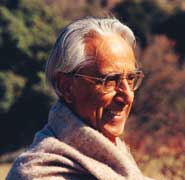




A-dualism, advaita
“When one has experienced that God is in everything and that everything is in God and that, nonetheless, God is nothing of what is, then one is near to the realization, to the authentic advaitic experience that, as with all true experience, can neither be communicated nor expressed by means of concepts.” (The Trinity. Una experiencia humana primordial, Madrid, 1999).
Advaita is the Hindu doctrine of the non-duality (a-dvaita, “not two”) of all things, including the world and even God. Panikkar prefers to translate advaita as “a-duality”: the Divinity “is not individually separate from the rest of reality, nor is it totally identical to it”, as occurs with dualism and monism. Advaita should not be confused with monism, although some Western commentators affirm it to be so, and until recently it was even common opinion among Western theologians, and some still continue to consider it so.
The advaita doctrine is considered the summit of all the religions and philosophies, inasfar as they introduce the “supreme experience” of non-duality, the in-separability between the Self (âtman) and God (brahman) . Truth for the advaita is to come to the discovery that “âtman (the I) is Brahman (the Absolute)”, or what comes to the same (“Tat tvam asi” = “Thou are That or He”, the Absolute), without ceasing to be different. In advaita, God and the world are not juxtaposed, nor is the one absorbed by the other, but rather in a reciprocal relation: the Absolute is at once transcendent and immanent. As Panikkar puts it, “The transcendent dimension excludes monistic identification, while the immanent prevents the dualistic.”
“God is not the Self (monism) nor the Other (dualism). God is one pole of Reality, a constitutive pole; silent and as such ineffable, but who speaks in us; transcendent, but immanent in the world; infinite, but limited in things. This pole is nothing in itself. It does not exist except in its polarity, in its relation. God is relation, intimate internal relationship with everything.” The Experience of God. Icons of the Mystery, Minneapolis 2006).
In this understanding there is nothing that is not sacred, nor is there anything absolutely sacred, separate from the rest. Everything has a sacred dimension: “The sacred is an aspect of everything by the very fact that things are real.” This is the understanding of divinity and of the sacred that to Panikkar seems most in accord with Christianity. The concept of advaita is fundamental to Panikkar’s thought, in concert with his other concept of ontonomy and in application to the trinitarian dynamic as much toward the divine interior as toward all of reality. “Advaita and ontonomy are the two faces of the same coin (Francis X. D’Sa).
Neither dualism nor monism, the a-dualistic understanding of Reality has stimulated our author toward a fuller more deeply rooted conception of the Trinity. For Panikkar, the Christian event can neither be understood as dualistic nor as monistic, but only as Trinitarian-advaita, as we shall see. This deals with something at the nucleus of his vision of God which we will take up again later in greater depth. It is not only the theme of the Trinity but also that of the personal reality of God that our author does not deny, but which he interprets by integrating the Trinity into a polyphonic vision of the Divinity.
official site